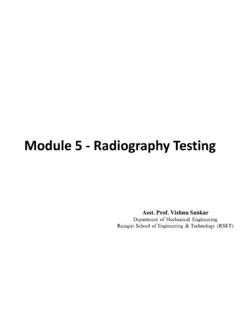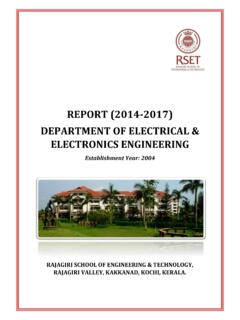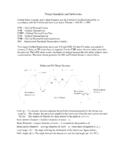Transcription of DESIGN OF MACHINE ELEMENTS - Rajagiri School of ...
1 DESIGN OF MACHINE ELEMENTS . Nivish George Threaded Joints: Types Department of Mechanical Engineering 2. Cap screws with different heads Department of Mechanical Engineering 3. screw Threads: Terminology Department of Mechanical Engineering 4. screw Threads: Terminology Major diameter: The major diameter is the diameter of an imaginary cylinder that bounds the crest of an external thread (d) or the root of an internal thread (D) (Also called as nominal diameter). Minor diameter: The minor diameter is the diameter of an imaginary cylinder that bounds the roots of an external thread (dc) or the crest of an internal thread (Dc).
2 Pitch diameter: The pitch diameter is the diameter of an imaginary cylinder, the surface of which would pass through the threads at such points as to make the width of the threads equal to the width of spaces cut by the surface of the cylinder Department of Mechanical Engineering 5. screw Threads: Terminology Pitch, p: It is the distance between two similar points on adjacent threads measured parallel to the axis of the thread Lead: It is the distance that the nut moves parallel to the axis of the screw , when the nut is given one turn thread angle: It is the angle between the sides of the thread measured in an axial plane Tensile stress area: Tensile strength of the threaded rods is equal to the tensile strength of the unthreaded rod whose diameter is equal to the mean of the pitch and the minor diameter.
3 The cross sectional area of this unthreaded rod is called as tensile stress area Department of Mechanical Engineering 6. screw Threads: Standards thread : Symmetrical V thread with thread angle 55 deg. Used in bolts and screwed fastenings thread : threads with fine pitches. Instruments and other precision works american national standard thread : Flat crest and roots. General purpose threads in bolts, nuts and tapped holes Department of Mechanical Engineering 7. screw Threads: Standards Unified standard thread : Included angle of 60 deg. Square thread : High efficiency and are used for power transmission.
4 Not strong as V threads but offers lesser frictional resistance Department of Mechanical Engineering 8. screw Threads: Standards Acme thread : Modification of square thread . Used in screw cutting lathes, bench vices Knuckle thread : A modification of square thread with rounded top and bottom. Necks of glass bottles, large moulded insulators Buttress thread : Power transmission in one direction. Has the advantage of square and V thread Metric thread : Same as with an included angle of 55 deg Department of Mechanical Engineering 9. Bolted Joint: DESIGN Procedure 1. Initial stresses due to screwing up forces (Tensile).
5 = 2805 (Eqn. ). 2. Tensile stress due to external forces 2. = 1 . 4. 3. Shear stress = 1 . 4. Combined tension and shear stress 1. = 2 + 4 2. 2. 1 Bolt in Tension = + 2 + 4 2. 2 2. Department of Mechanical Engineering 10. Problem An eye bolt is to be used for lifting a load of 10 kN. The eye bolt is screwed into the frame of the motor. The eye bolt has coarse threads. It is made of plain carbon steel 30C8 (Syt = 400N/mm2) and factor of safety is 6. Determine the size of the bolt Problem Two plates are fastened by means of two bolts as shown in Figure. The bolts are made of plain carbon steel 30C8 (Syt = 400N/mm2) and the factor of safety is 5.
6 Determine the size of the bolts, if P = 5kN. Department of Mechanical Engineering 11. Eccentric load acting in the plane containing the bolts 1 1 + 2 2 + 3 3 +.. =. 1 + 2 + 3 + . 1 + 2 + 3 +.. =.. Direct shear, = Eqn (a). Secondary shear proportional to the radial distance from the centre of gravity (assumption). 1 2 3. = = = . 1 2 3. Eqn (d). 1. 1 = 2. ( 1 + 22 + 32 + 42 ). Eqn (g). = 1 + 1 + 2 1 1 . Department of Mechanical Engineering 12. Problem A steel plate subjected to a force of 5 kN and fixed to a channel by means of three identical bolts is shown in Figure.
7 The bolts are made from plain carbon steel 45C8 (Syt = 380 N/mm2) and the factor of safety is 3. Specify the size of bolts Department of Mechanical Engineering 13. Eccentric load acting perpendicular to the axis of the bolt . Direct shear, = (Eqn ). 1. Secondary tensile, 1 = (Eqn ). 2( 12 + 22 ). 1. Equivalent tensile load, = 1 + 1 2 + 4 2 (Eqn ). 2. 1 2. DESIGN bolt for Equivalent shear load, = 1 2 + (Eqn ). 2 the total load Department of Mechanical Engineering 14. Problem A wall bracket is attached to the wall by means of four identical bolts, two at A and two at B as shown in Figure.
8 Assuming the bracket is held against the wall and prevented from tipping about the point C by all four bolts and using an allowable tensile stress = 35 N/mm2 , determine the size of the bolts on the basis of maximum principal stress theory. Department of Mechanical Engineering 15. Eccentric load acting parallel to the axis of the bolt . Direct Tensile, = (Eqn ).. 2. Secondary tensile, 1 = (Eqn ). 2( 12 + 22 ).. Total load, = + 1. DESIGN bolt for the total load . Department of Mechanical Engineering 16. Problem A crane runway bracket is fastened to the roof truss by means of two identical bolts as shown in Figure.
9 Determine the size of the bolts, if the permissible tensile stress in the bolts is limited to 75 N/mm2. Department of Mechanical Engineering 17. Problem Figure shows the bracket used in a jib crane to connect the tie rod. The maximum force in the tie rod is 5 kN, which is inclined at an angle 300 with horizontal. The bracket is fastened by means of four identical bolts, two at A and two at B. The bolts are made of plain carbon steel 30C8 (Syt = 400. N/mm2) and the factor of safety is 5. Assume maximum shear stress theory and determine the size of the bolts. Department of Mechanical Engineering 18.
10 Problem A rigid bracket subjected to a vertical force of 10 kN is shown in Figure. It is fastened to a vertical stanchion by means of four identical bolts. Determine the size of the bolts by maximum shear stress theory. The maximum permissible shear stress in any bolt is limited to 50 N/mm2. Department of Mechanical Engineering 19. Eccentric load acting perpendicular to the axis of the bolt . Direct shear load, = (Eqn ).. 1. Secondary tensile, 1 = 2 (Eqn ). ( 1 + 22 + 32 + 42 ). 1 = cos 2 = + sin . DESIGN bolt for 3 = + cos 4 = sin . the total load 2 ( ) (Eqn ) 180. 1 = + cos( ).















